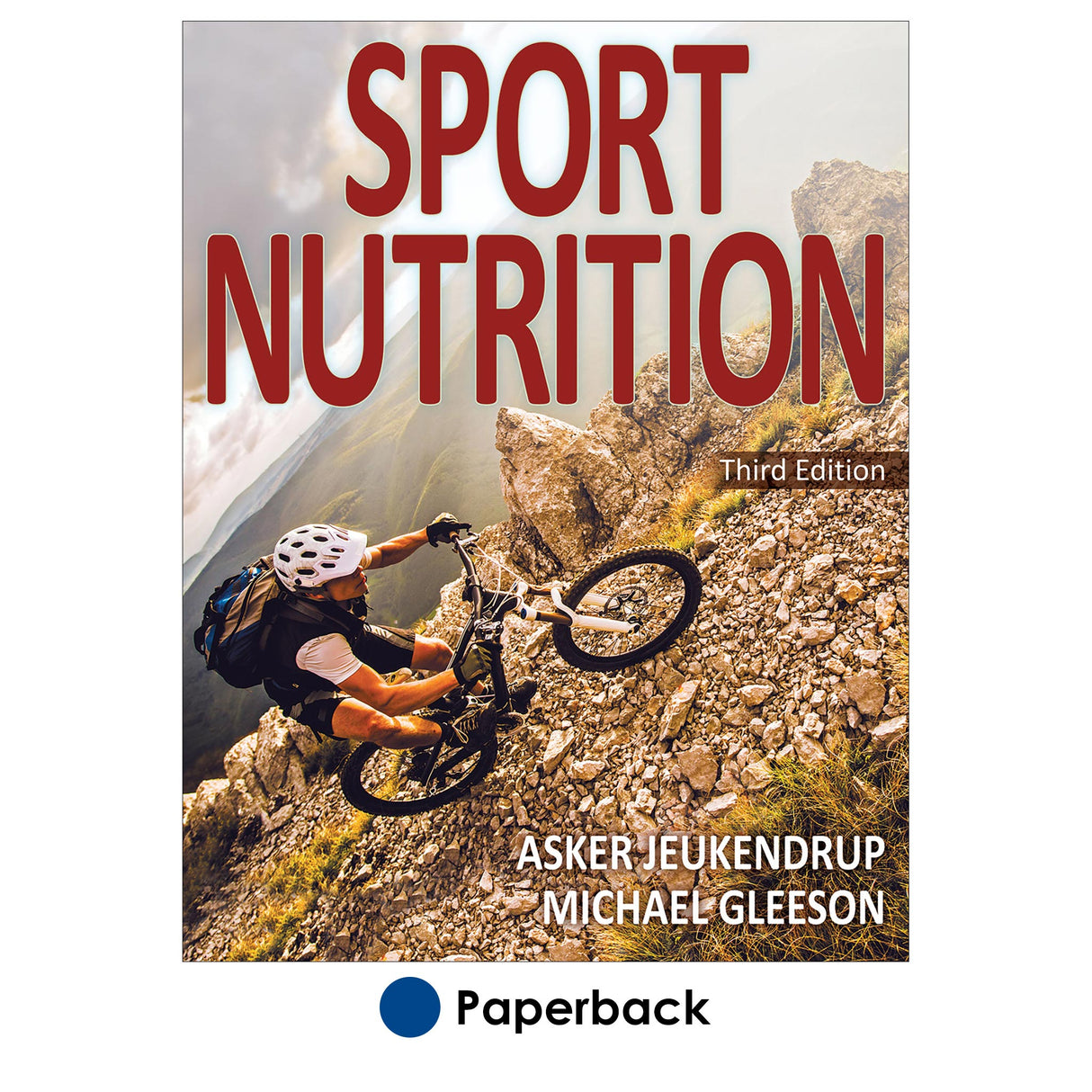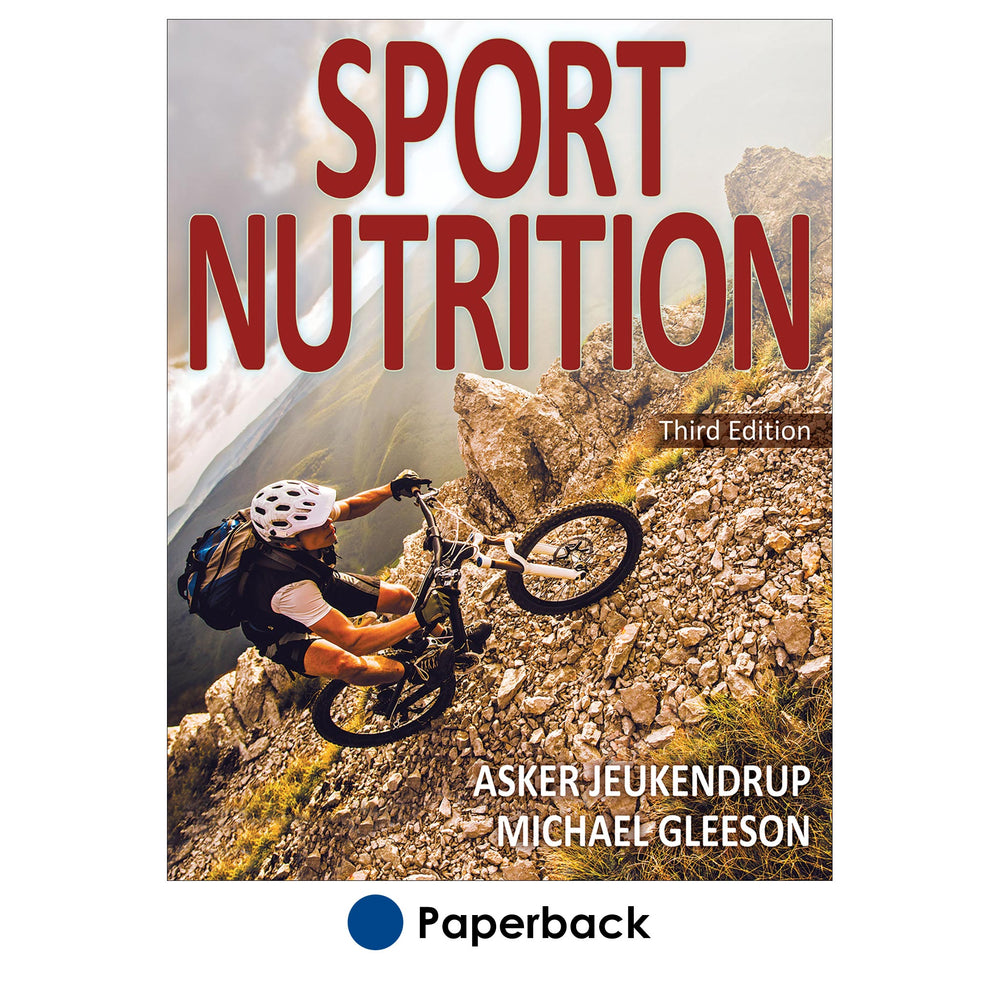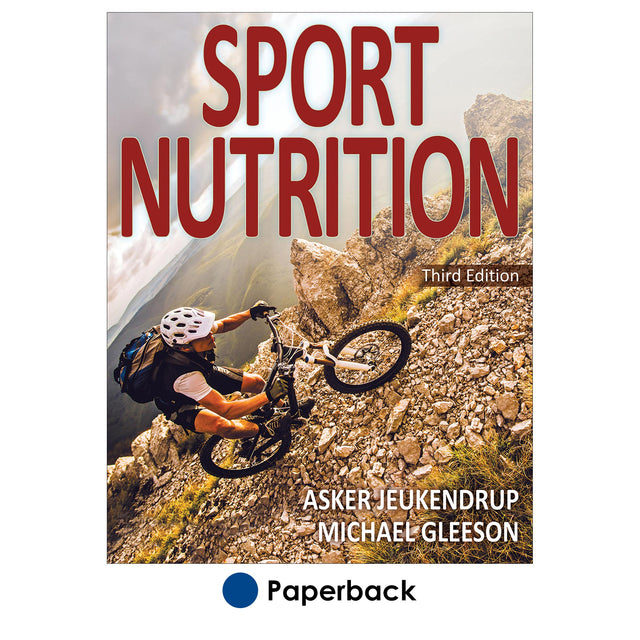Sport Nutrition 3rd Edition
Author: Asker Jeukendrup, Michael Gleeson
$119.00 USD
Sport Nutrition, Third Edition, presents the principles and rationale for current nutrition guidelines for athletes. Using a physiological basis, this text provides an in-depth look at the science behind sport nutrition. Students will come away with an understanding of nutrition as it relates to sport and the influence of nutrition on performance, training, and recovery.
This text is organized with the student in mind, with content sequenced in a logical order that puts building blocks in place to facilitate greater comprehension as more advanced topics are introduced. The book moves from general principles of nutrition and nutrient requirements to estimating and fulfilling energy needs with the appropriate combinations of macronutrients and micronutrients. Supplements are addressed from a scientific standpoint, followed by the influence of nutrition on training adaptations, immune function, body composition, weight management, and eating disorders. The new chapter on personalized nutrition covers periodized nutrition, gender differences, and special populations (young athletes, older athletes, and diabetic athletes) and offers practical examples from specific sports.
This third edition contains revised and expanded information to keep students current on the latest findings in sport nutrition:
• Updated nutrition guidelines
• A new chapter on personalized nutrition that helps readers move from theory into practice as they better understand how to customize nutrition based on an individual’s unique background and needs
• Addition of practical carbohydrate intake guidelines for athletes in a wide variety of sports
• Updated information on protein metabolism and recommendations on the type, amount, and timing of protein intake to maximize training adaptation
• Developments from the field of molecular biology that explain how adaptations to exercise training are influenced by nutrition
• Expanded coverage of the rapidly developing field of immunonutrition
Sport Nutrition, Third Edition, includes a number of tools to facilitate student learning. More than 300 figures, tables, and photos offer visual illustration of important concepts, methods, and research findings. Updated and new sidebars provide in-depth coverage of selected topics, making it easier to grasp the scientific concepts presented. Each chapter also includes learning objectives and key points to help students retain the information.
In addition to being mindful of students, the authors remained conscious of the needs of instructors. With years of experience in teaching sport nutrition, the authors constructed chapters in a natural progression, making class lectures easier to prepare and deliver. Instructors will also find an ancillary package consisting of an instructor guide, test package, and presentation package plus image bank to further support their efforts.
More than a simple prescription of recommendations, Sport Nutrition, Third Edition, offers a systematic presentation of the science supporting nutrition guidelines. It is an ideal book to provide a comprehensive understanding of nutrition as it relates to sport, exercise performance, training, and recovery.
Audience
Text for upper undergraduate and graduate courses in sport science, exercise physiology, and other sport- or exercise-related degree programs; reference for sport nutritionists, dietitians, and other physical activity professionals.
Chapter 1. Nutrients and Recommended Intakes
Function of Nutrients
Carbohydrate
Fat
Protein
Water
Alcohol
Vitamins, Minerals, and Trace Elements
Phytonutrients
Recommended Intakes of Nutrients
Development of Recommended Intakes
Current Recommended Intakes
Analyzing Dietary Intake
Chapter 2. Healthy Eating
Health Effects of Consuming Excess Amounts of Nutrients
Practical Guidelines for a Balanced, Healthy Diet
Recommendations for a Healthy Diet and Lifestyle
Nutrition Facts Labels
Nutrient Content and Health Claims on Food Packaging
Processed Food and Additives
Fat Substitutes
Chapter 3. Fuel Sources for Muscle and Exercise Metabolism
Subcellular Skeletal Muscle Structure
Force Generation in Skeletal Muscle
Fiber Types
Energy for Muscle Force Generation
Fuel Stores in Skeletal Muscle
Regulation of Energy Metabolism
Metabolic Responses to Exercise
Metabolic Adaptations to Exercise Training
Chapter 4. Energy
Energetic Efficiency
Measuring the Energy Content of Food
Measuring Energy Expenditure
Components of Energy Expenditure
Energy Balance
Chapter 5. Gastric Emptying, Digestion, and Absorption
Anatomy of the Gastrointestinal Tract
Regulation of the Gastrointestinal Tract
Digestion
Absorption
Gut Microbiota
Regulation of Gastric Emptying
Gastrointestinal Problems During and After Exercise
Chapter 6. Carbohydrate
History
Role of Carbohydrate
Recommendations for Carbohydrate Intake
Carbohydrate Intake in the Days Before Competition
Carbohydrate Intake in the Hours Before Exercise
Carbohydrate Intake 30 to 60 Minutes Before Exercise
Carbohydrate Intake During Exercise
Carbohydrate Intake After Exercise
Chapter 7. Fat
Fat Metabolism During Exercise
Limits to Fat Oxidation
Fat as a Fuel During Exercise
Regulation of Carbohydrate and Fat Metabolism
Fat Supplementation and Exercise
Effects of Diet on Fat Metabolism and Performance
Chapter 8. Protein and Amino Acids
Amino Acids
Techniques to Study Protein and Amino Acid Metabolism
Protein Requirements for Exercise
Training and Protein Metabolism
Effect of Protein Intake on Protein Synthesis
Amino Acids as Ergogenic Aids
Protein Intake and Health Risks
Chapter 9. Water Requirements and Fluid Balance
Thermoregulation and Exercise in the Heat
Effects of Dehydration on Exercise Performance
Mechanisms of Heat Illness
Effects of Fluid Intake on Exercise Performance
Daily Water Balance
Fluid Requirements for Athletes
Chapter 10. Vitamins and Minerals
Water-Soluble and Fat-Soluble Vitamins
Recommended Intakes of Vitamins
Recommended Intakes of Vitamins for Athletes
Macrominerals and Microminerals
Recommended Intakes of Minerals
Critical Micronutrient Functions
Assessing Micronutrient Status
Exercise and Micronutrient Requirements
Ergogenic Effect of Micronutrient Supplementation
Summary of Recommendations for Micronutrient Intake in Athletes
Chapter 11. Nutrition Supplements
Relative Importance of Supplements to a Normal Diet
Nonregulation of Nutrition Supplements
Critical Evaluation of Nutrition Supplements Studies
Androstenedione
Bee Pollen
Beetroot Juice
Beta Alanine and Carnosine
Beta-Hydroxy Beta-Methylbutyrate
Boron
Caffeine
Carnitine
Cherry Juice
Choline
Chromium
Coenzyme Q10
Creatine
Dehydroepiandrosterone
Fish Oil and Omega-3 Fatty Acids
Ginseng
Glandulars
Glycerol
Green Tea
Inosine
Ketone Salts
Lactate Salts and Polylactate
Lecithin
Medium-Chain Triacylglycerol
Pangamic Acid
Phosphatidylserine
Phosphorus and Phosphate Salts
Polyphenols
Pyruvate and Dihydroxyacetone
Sodium Bicarbonate
Sodium Citrate
Sodium Nitrate
Vanadium
Wheat Germ Oil
Additive Effects of Combining Different Supplements
Contamination of Nutrition Supplements
Chapter 12. Nutrition and Training Adaptations
Training Adaptations
Signal Transduction Pathways
Starting a Signaling Cascade
Secondary Signals
Nutrition and Effects on Training Adaptations
Overreaching and the Overtraining Syndrome
Nutrition and Effects on Sleep
Nutrition and Effects on Rehabilitation
Chapter 13. Nutrition and Immune Function in Athletes
Functions of the Immune System and Its Cellular Components
General Mechanism of the Immune Response
Causes of Illness in Athletes
Effects of Exercise on the Immune System
Nutritional Manipulations to Decrease Immunodepression in Athletes
Conclusions and Recommendations
Chapter 14. Body Composition
Optimal Body Weight and Composition
Body Composition Models
Normal Ranges of Body Weight and Body Fat
Body Composition Measurement Techniques
Chapter 15. Weight Management
Genetics
Energy and Macronutrient Intake
Regulation of Appetite
Effect of Exercise on Appetite
Physical Activity and Energy Expenditure
Dietary Weight-Loss Methods
Exercise for Weight Loss
Decreased Resting Metabolic Rate With Weight Loss
Weight Cycling
Gender Differences in Weight Loss
Practicalities of Weight Loss for Athletes
Weight Gain
Chapter 16. Eating Disorders in Athletes
Types of Eating Disorders
Prevalence of Eating Disorders in Athletes
Effects of Eating Disorders on Sports Performance
Effects of Eating Disorders on Health
Treatment and Prevention of Eating Disorders
Chapter 17. Personalized Nutrition
Genetic Influences
Turning Science Into Practice
Specific Populations
Nutrition Application in Different Sport Situations and Populations
Appendix A. Key Concepts in Biological Chemistry Relevant to Sport Nutrition
Appendix B. Unit Conversion Tables
Appendix C. Recommended Daily Allowances for North America
Appendix D. Reference Nutrient Intakes for the United Kingdom
Appendix E. Recommended Dietary Intakes for Australia and New Zealand
All ancillaries are free to adopting instructors through HKPropel.
Instructor guide. Each chapter of the instructor guide includes a recommended class format, chapter objectives, a detailed outline of the chapter (which could form the structure of a lecture), and sample student assignments. In addition, suggestions for practical lab classes are offered for some of the chapters. Also included are a sample syllabus and list of useful websites.Test package. Contains 674 questions in multiple-choice, true or false, fill-in-the-blank, and short answer formats that can be used to create customized tests.
Presentation package plus image bank. Features 705 PowerPoint slides containing key content, figures, and tables from the text. Slides can be added, modified, or rearranged as needed. The image bank includes most of the figures, photos, and tables from the text—sorted by chapter—to provide instructors with additional flexibility in creating their own customized presentations, handouts, and other course resources.





